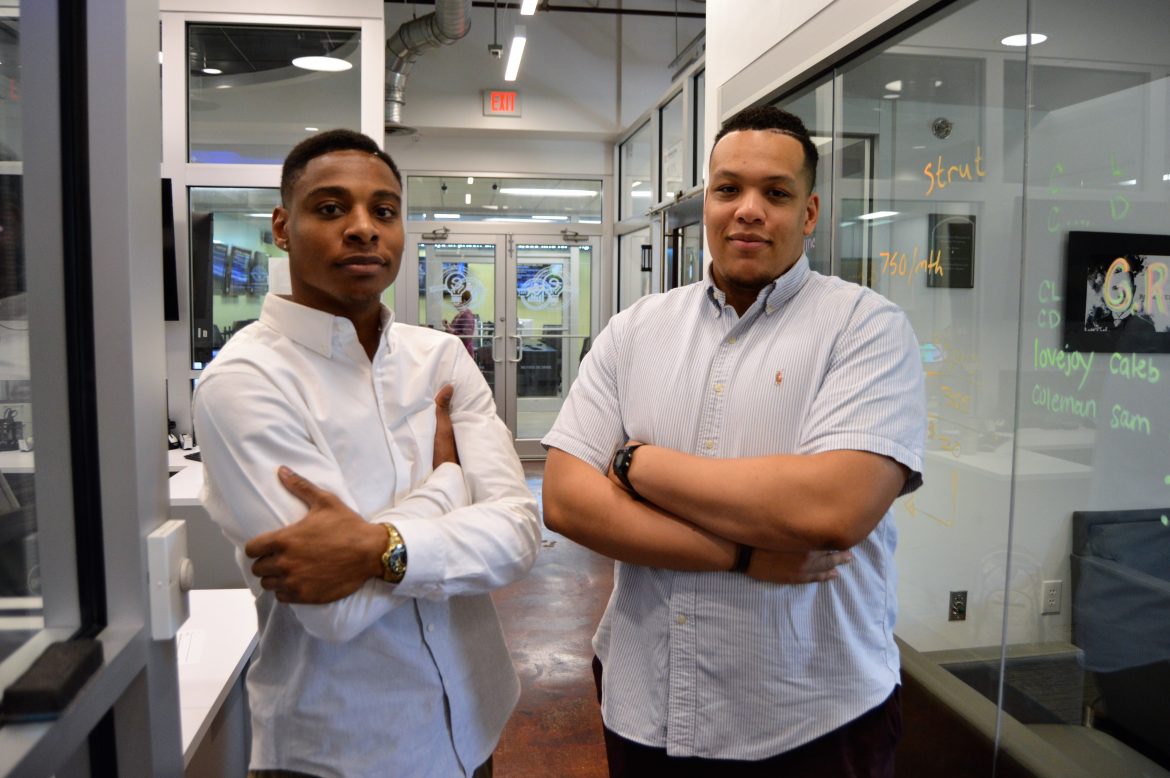Story by: Tom Lammert, Lecturer at MSU Department of English
Tyler Anthony, a 23-year-old senior at Mississippi State University, slides onto the barber’s chair. Thomas White, Tyler’s barber and college friend, unfurls a barber’s cape. At this moment Thomas’s waving of the cape makes him look like a matador attracting a bull, but instead of a lance, he wields scissors, a comb, and a clipper with multiple length attachments that range from one millimeter to a quarter of an inch. He drapes the cape across Tyler’s chest, clicks the switch on the side of his clipper. It buzzes to life but his grip remains steady as he places the blade against the base of Tyler’s neck.
Tyler tells Thomas he wants maybe a one-millimeter cut on the sides and back of his head. “But leave it a little longer on top.”
So Thomas starts to give Tyler a drop fade.
The clipper rattles Tyler’s skull as it swipes from the base of his neck, stops when it’s level with his temples. Thomas pulls the clipper away from Tyler’s head and maneuvers it back to the bottom of Tyler’s neck where he plans to continue cutting but before he can press the clipper against Tyler’s neck it feels like his hand hovers above a flame. His clipper overheated. He tells Tyler to wait a minute, he needs to switch to his backup tools.
Scenes such as this aren’t uncommon to Thomas. To earn a little money to help himself through school, Thomas apprenticed at a barbershop and cut his friends’ hair. It was during these years that Thomas heard his colleagues’ complaints about overheated clippers. He, too, had experienced this problem; he wanted a product he could rely on, not the old tools that ran on outdated technology. While cutting Tyler’s hair one afternoon, Thomas mentioned his idea to create a clipper that would allow a barber to run the tool all day without it overheating to the point it felt like holding a glowing chunk of charcoal.
Tyler, an engineering student who had earned a position at a co-op in Flowood, MS, mentioned to Thomas that 3D-printing “is pretty powerful stuff. It really [seems] like a game-changer to start a business.”
With their combined skills – Thomas obsessed with watching and creating and publishing haircut tutorials on YouTube, and Tyler obsessed with “the power to create” using 3D-printing – the two formed DueTT Technology. They set out to design their first product: the DueTT Clipper, an all-in-one clipper-shaver-trimmer.
The duo knew they wanted to create the DueTT Clipper, but instead of focusing the entirety of their efforts on the creation of the product, they started their business by marketing their brand. According to Thomas, “We didn’t think it would be smart to come up with a product first and then try to find someone to sell it to. We’d rather build the customer base first.”
Tyler agrees with Thomas, adding that before they launch the DueTT Clipper they need to establish a trustworthy brand because “a lot of barbers get the same products from the brands they’ve heard of.” Why risk the local coffee shop when Starbucks is right across the street? Because the DueTT Clipper won’t simply be a versatile tool; it will also include a state-of-the-art cooling system to prevent overheating. Even with this innovative advantage, Tyler and Thomas recognize that they’re new to the game and need to establish their credibility with potential clientele.
Although DueTT Technology has not released its product for beta testing, a trip to the company’s website makes it clear that Tyler and Thomas are devoted to fostering a community of barbers and others who appreciate the artistry required for giving a good haircut. The company uses this web presence to contact barber colleges across six states and individual barbers. These conversations leave both men feeling optimistic about barbers’ needs for a clipper that won’t overheat – they claim 95% of the barbers they surveyed are excited about the promise of the DueTT Clipper’s cooling technology.
But the preliminary successes – the website, the YouTube tutorials, the conversations with future clientele – wouldn’t have manifested without the E-Center. Tyler knew the DueTT Clipper wouldn’t be cheap or easy to produce, so he and Thomas sought a meeting with the E-Center staff. Luckily for Tyler and Thomas, they met with Michael Lane, a fellow engineering student and entrepreneur, who helped them get their idea for the DueTT Clipper on the right track by suggesting materials that might serve the product’s purpose of staying cool.
Before meeting with Michael, Tyler and Thomas felt confident in their product and business model, but Tyler says, “There’s always more to learn. You don’t know what you don’t know. When we came [to the E-Center] we realized [the staff] was teaching others how to get their businesses and products off the ground on a regular basis.” So far the E-Center has provided DueTT Technology with $2,500. Tyler and Thomas hope these funds can lead to a beta-test of the DueTT Clipper later this year.
While barbers around the world await the arrival of the DueTT Clipper, Tyler continues to perfect the product’s modeling, and Thomas continues to refine his shadow fades and bald tapers … if his clippers don’t overheat. But – soon enough – he’ll barber with his own product, and he’ll no longer have to fear halting a haircut to switch clippers.

